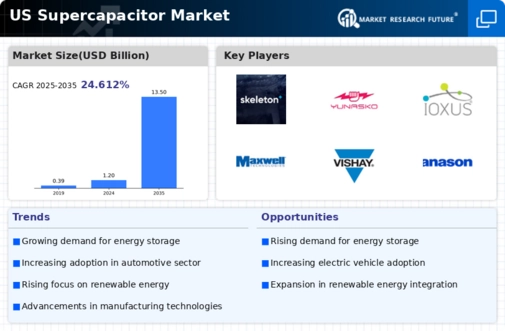Focus on Sustainable Energy Solutions
The super capacitor market is likely to benefit from the growing focus on sustainable energy solutions in the US. As environmental concerns gain prominence, both consumers and businesses are seeking alternatives to traditional energy storage methods. Super capacitors, known for their eco-friendly characteristics and recyclability, are becoming a preferred choice for various applications. The US government has implemented policies aimed at promoting sustainable technologies, which further supports the growth of the super capacitor market. With an increasing number of companies committing to sustainability goals, the demand for super capacitors is expected to rise, as they align with the broader trend of reducing carbon footprints and enhancing energy efficiency.
Growth in Renewable Energy Integration
The super capacitor market is poised for growth as the integration of renewable energy sources becomes increasingly prevalent in the US. With a significant push towards solar and wind energy, the need for efficient energy storage solutions is paramount. Super capacitors offer a unique advantage in balancing supply and demand, particularly in grid applications where rapid energy discharge is required. The US Department of Energy has reported that renewable energy sources accounted for over 20% of the total electricity generation in 2023, a figure that is expected to rise. This shift towards renewables creates a favorable environment for the super capacitor market, as utilities and energy providers seek reliable storage options to enhance grid stability and efficiency.
Rising Demand for Consumer Electronics
The super capacitor market is experiencing growth driven by the rising demand for consumer electronics in the US. As devices become more sophisticated, the need for efficient energy storage solutions that can support quick charging and discharging cycles is critical. Super capacitors are increasingly being utilized in smartphones, tablets, and wearable technology, where they complement traditional batteries by providing additional power during peak usage. Market analysis indicates that the consumer electronics sector is expected to grow at a CAGR of around 10% through 2026, which bodes well for the super capacitor market. This trend suggests that manufacturers will continue to seek innovative energy storage solutions to meet consumer expectations for performance and longevity.
Increasing Adoption of Electric Vehicles
The super capacitor market is experiencing a notable surge due to the increasing adoption of electric vehicles (EVs) in the US. As consumers and manufacturers alike prioritize sustainability, the demand for efficient energy storage solutions has escalated. Super capacitors, with their rapid charge and discharge capabilities, are becoming integral to EV technology, enhancing performance and extending battery life. According to recent data, the EV market in the US is projected to grow at a CAGR of approximately 25% through 2030, which directly correlates with the rising need for super capacitors. This trend indicates a robust opportunity for the super capacitor market, as automakers seek to integrate advanced energy storage systems to meet consumer expectations and regulatory standards.
Technological Innovations in Energy Storage
The super capacitor market is benefiting from ongoing technological innovations that enhance energy storage capabilities. Advances in materials science and engineering are leading to the development of super capacitors with higher energy densities and improved cycle life. These innovations are crucial for applications in consumer electronics, industrial machinery, and renewable energy systems. The US market has seen a rise in research and development investments, with funding from both private and public sectors aimed at improving super capacitor performance. As a result, the market is likely to witness a shift towards more efficient and cost-effective super capacitor solutions, which could potentially increase market penetration across various sectors.
















Leave a Comment